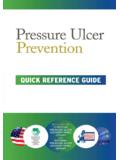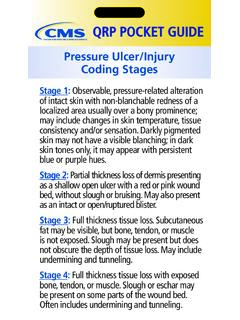Transcription of Pressure ulcer core curriculum - england.nhs.uk
1 Pressure ulcer core curriculum June 2018 We support providers to give patients safe, high quality, compassionate care within local health systems that are financially sustainable. 1 | Contents Contents Summary .. 2 1. Introduction .. 4 2. curriculum outline framework .. 5 3. Professional registration .. 7 4. Academic modules .. 9 5. curriculum outline for clinical organisation education programmes .. 26 6. Individual practitioner 48 7. Suggested resources .. 51 8. References .. 52 Appendix 1: Working group members and affiliation .. 54 Appendix 2: Consultation group .. 55 2 | Summary Summary The national Stop the Pressure programme has designed a core curriculum to guide education for nurses and other healthcare professionals on preventing Pressure ulcers. Pressure ulcers remain a challenge for the patients who develop them, and the healthcare professionals involved in their prevention and management. Data from the NHS Safety Thermometer (2018) suggests that despite extensive programmes of prevention, the annual incidence is still (April 2017 to March 2018) in England.
2 Analysis of why patients develop Pressure ulcers in healthcare settings suggests lack of education for staff is a key factor (Greenwood and McGinnis 2016). However, there is no current curriculum standard for Pressure ulcer education for nurses or other healthcare professionals. Recent data (Schofield 2018) suggests there is inconsistency in the frequency and length of time organisations spend on Pressure ulcer prevention education. Therefore, the national Stop the Pressure programme has designed a core curriculum to guide education for nurses and other healthcare professionals. The content was developed by an education working party with a broad range of clinical and academic experience (see Appendix 1). The curriculum has been designed in such a way that is to be useful to a range of education providers and to the learner. It consists of three main sections: 1. a framework for use in academic settings containing aims, learning outcomes, theory and skills components 2.
3 A framework for clinical staff delivering education in their clinical setting; this version has content headings on three levels fundamental, intermediate and advanced 3 | Summary 3. a framework for individual learning to guide practitioners on how to make the best of the content through reflective practice and how to capture what they have learned to support their revalidation. Another section recommends resources to support the content, and for the learner to support knowledge and understanding. The resources are all used and well-evaluated in clinical practice, and have been generously shared by the teams that developed them. If you use these resources in practice, please acknowledge the original source of the material. 4 | Introduction 1. Introduction Pressure ulcers (PUs) remain a challenge for the patients who develop them, and the healthcare professionals involved in their prevention and management. Data from the NHS Safety Thermometer (2018) suggests that despite extensive programmes of prevention the annual incidence is still (April 2017 to March 2018) in England.
4 This is based on 2,099,216 patients, of whom 18,789 were reported as developing Pressure ulcers during the year. The data does not include patients who had existing Pressure damage. Analysis of why patients develop Pressure ulcers in healthcare settings regularly suggests lack of education for staff is a key factor (Greenwood and McGinnis 2016). However, there is no current curriculum standard for Pressure ulcer education for nurses or other healthcare professionals. Recent data (Schofield 2017) suggests there is inconsistency in the frequency and length of time organisations spend on focused Pressure ulcer prevention education (see Table 1), with some embedding this in mandatory training and others not. Table 1: How frequent is your trust Pressure ulcer training delivered? Yearly Every two years Every three years Every five years and above One-off/ induction None More frequent than yearly 24 16 10 1 11 16 2 Source: Schofield 2017 5 | curriculum outline framework 2.
5 curriculum outline framework In developing the curriculum content, we considered existing models such as the SSKIN bundles (Whitlock 2013), which are used widely in current practice, and evidence has shown their impact on clinical care (McCoulough 2016). The SSKIN care bundle defines and ties best practices together. It also makes the process of preventing Pressure ulcers visible to all. This minimises variation in care practices. SSKIN is a five-step model for Pressure ulcer prevention: Surface: make sure your patients have the right support Skin inspection: early inspection means early detection show patients and carers what to look for Keep your patients moving Incontinence/increased moisture your patients need to be clean and dry Nutrition/hydration help patients have the right diet and plenty of fluids. A care bundle is a series of actions required to achieve a desired outcome (such as reducing the number of Pressure ulcers).
6 Reliably delivering all elements of the care bundle at every care opportunity will improve a patient s Pressure area care. This will have impact on improving care outcomes. We have developed 10 modules primarily around an extended SSKIN framework, which becomes ASSKING: 6 | curriculum outline framework A Assess risk S Skin assessment and skin care S Surface K Keep moving I Incontinence N Nutrition G Giving information The group was aware of the impact on local activity and the potential to confuse clinical staff by changing from the well-known SSKIN. The ASSKING model therefore recognises that modules have different emphases, with SSKIN representing the fundamental elements of care delivery ie those things that need to be implemented to prevent Pressure ulcers occurring while the other elements underpin and support successful implementation of care. In addition to the ASSKING modules, there are three further modules: Anatomy and physiology and Core concepts , which were felt to be necessary to prevent repetition of this information throughout the other modules.
7 In addition, Medical device-related Pressure ulcers (MDRPU) was also felt to be a specific area which, while some of the content may be covered in the generic modules, warranted a focused module. Each module s content was developed by the core working group (see Appendix 1 for members). We consulted a wider group to find out how applicable the modules are to more specialist areas (see Appendix 2 for those who reviewed the document). 7 | Professional registration 3. Professional registration All nurses and midwives must achieve a minimum standard of education to register (Nursing and Midwifery Council 2010). Following registration, the Nursing and Midwifery Council (NMC 2015) states that all registered nurses should: be responsible and accountable for keeping their knowledge and skills up to date through continuing professional development; they must aim to improve their performance and enhance the safety and quality of care through evaluation, supervision and appraisal practise independently, recognising the limits of their competence and knowledge; they must reflect on these limits and seek advice from, or refer to, other professionals where necessary.
8 Similarly, the healthcare assistant role is defined by the Nursing and Midwifery Council as: Those who provide a direct service that is, they have a direct influence/effect on care and treatment to patients and members of the public, and are supervised by and/or undertake healthcare duties delegated to them by NMC registrants . Service providers should ensure all healthcare workers providing Pressure ulcer care and assessment meet standards of education and competence. Similar requirements to meet standards exist for allied health professionals. They state in broad terms the behaviours expected of professionals registered with the Health and Care Professions Council (HCPC 2018a). To meet the standards for continuing professional development (CPD), a registrant must: 1. maintain a continuous, up-to-date and accurate record of their CPD activities 2. demonstrate that their CPD activities are a mixture of learning activities relevant to current or future practice 3.
9 Seek to ensure that their CPD has contributed to the quality of their practice and service delivery 8 | Professional registration 4. seek to ensure that their CPD benefits the service user 5. on request, present a written profile (which must be their own work and supported by evidence) explaining how they have met the standards for CPD (HCPC 2018b). 9 | Academic modules 4. Academic modules This section contains suggested outlines for modules that academic staff may develop to different levels and include in relevant academic pathways. These modules have been developed using a broad evidence base, including national and international guidelines (NICE 2014, NPUAP, EPUAP, PPPIA 2014) and existing standards, including those from NICE (2015) and Healthcare Improvement Scotland (2017): see Table 1. The module outlines are written in a broad format. We envisage that the wording will be adjusted to the level of education being delivered and language appropriate to the learner.
10 Table 1: Existing standards relating to Pressure ulcer prevention NICE Healthcare Improvement Scotland People admitted to hospital or a care home with nursing have a Pressure ulcer risk assessment within six hours of admission. The organisation demonstrates leadership and commitment to the prevention and management of Pressure ulcers. People with a risk factor for developing Pressure ulcers who are referred to community nursing services have a Pressure ulcer risk assessment at the first face-to-face visit. The organisation demonstrates commitment to the education and training of all staff involved in the prevention and management of Pressure ulcers, appropriate to roles and workplace setting. Information and support is available for people at risk of, or identified with, a Pressure ulcer , and/or their representatives. People have their risk of developing a Pressure ulcer reassessed after a surgical or interventional procedure or after a change in care environment following a transfer.















